Franz Kafka is one of the most famous writers of the 20th century, and Prague, his birthplace, played a significant role in his life and work.
From the house where he was born to the cafes where he wrote some of his most famous works, this tour takes you on a journey through Kafka’s Prague. Join me as I explore the places that inspired Kafka and discover where Kafka was born, where he wrote some of his stories and diaries, and where he worked and met his friends.
I’ve also included places where you can learn more about Kafka and places that were inspired by him. I’ve enjoyed doing the research for this walk, as many of the houses are not marked with ‘here is where Kafka lived’, but I think this makes the walk that much more special.
Most of the places are close to each other in the centre of Old Town and the Jewish Quarter, so by following my walk, you’ll also walk through the main tourist centre, just probably looking at different houses than most other people!
Who was Franz Kafka?
Franz Kafka (1883-1924) was a German-writing Prague writer and author of the novels The Trial, The Castle, and Amerika and one of the most significant figures in world literature of the 20th century. His work and life are fascinating and rather sad at the same time. He had a complicated relationship with his father and with most of the women in his life.
He considered his writing to be his main objective in life, but then he asked his friend Max Brod to burn all his work and diaries after he died. Brod didn’t honour his friend’s will and published some of the work and diaries, but there are still many left unpublished.
Kafka spent most of his short life in Prague’s Old Town. When he was growing up, his family moved a lot, so you will come across traces of Franz Kafka in the Old Town almost everywhere, especially around Old Town Square.
I’ve picked the more significant houses, where Kafka stayed for a longer period of time. As you walk on the tour bear in mind what Kafka himself had to say about his home city; ‘Prague doesn’t let go, either or you or me. This little mother has claws. There is nothing for it but to give in.’
How to use this self-guided tour of Franz Kafka in Prague
I’ve tried to keep the places in chronological order but also grouped together so that the places are close to each other and you don’t need to run from one side of Prague to another.
The best place to start the walk is at Kafka’s Square, which is a small square behind the Old Town Square, where Kafka was born.

Kafka’s Birthplace
Location: Kafka’s Square, Old Town
Kafka was born on July 3 1883 in a house called ‘Close to the Tower or the Tower House’ which stood on the corner of Maiselova and Kaprova streets, close to the Old Town Square. During the mass demolition of old houses in Prague at the turn of the 19th and 20th centuries, only the original stone portal remained, which was incorporated into the new house.
To make things easier for today’s visitors, the little area before the houses is called Franz Kafka’s Square and you can see Kafka’s sculpture with a commemorative plaque on the house.
Náměstí Franze Kafky
Location: Namesti Franze Kafky, Old Town Square
There is also an artist display called ‘The Kafka’s World’ which was inspired by Kafka’s work and his life, but it’s not a museum about Kafka. It includes several art installations and short art films. The entry ticket is 300 CZK.

The Minute House
Location: The Old Town Square
From 1889 to 1896, the Kafka family lived in the charming house ‘U Minuty’ (The Minute House) with beautiful sgraffito decorations close to the Old Town Hall. Kafka lived in the first-floor flat and all of his three sisters were born there.

The Kinsky Palace
Location: Old Town Square
During 1893-1901 Kafka attended a German gymnasium (college) in today’s Kinský Palace. The school was based in the back part of the palace and you can still walk there today.
Kafka’s father Hermann Kafka had a haberdashery shop on the ground floor of the same building. The palace now houses the National Gallery, cafe and you can also visit the bookstore, where Kafka’s haberdashery shop used to be.
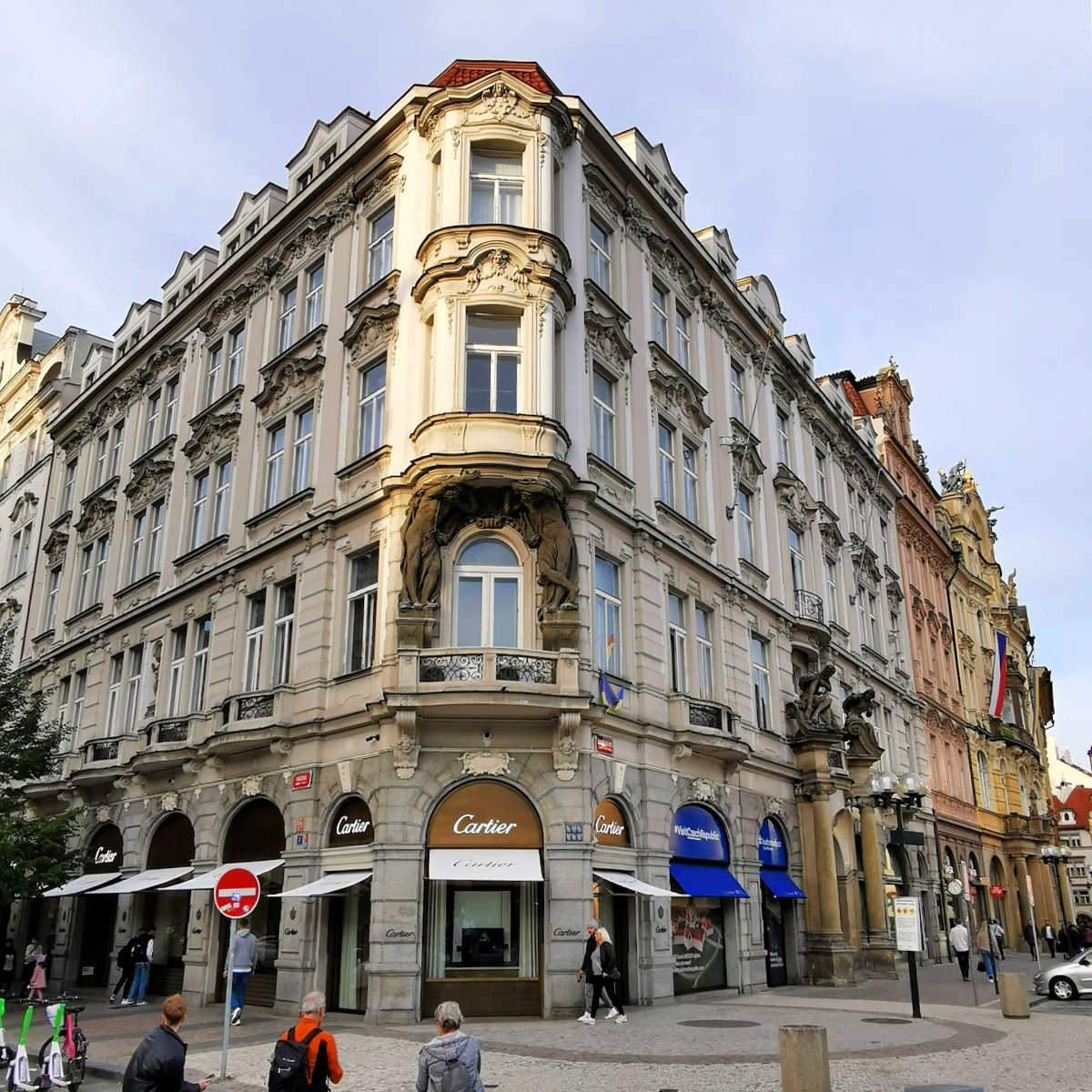
Opperts House
Location: 934/5, Old Town Square
Kafka used to live here from 1913 until 1924 with few gaps in between, when he rented a flat in Dlouha street, for example. The flat was on the top floor, which doesn’t exist anymore.
The house was bombed during the Second World War and when it was rebuilt afterwards the top floor, which was very damaged, wasn’t added back in. The house had originally a small tower in the corner (above the corner door), which was lost too.
Kafka has good memories of living in this flat and he describes in his diaries how he can see the whole square as well as the Church of St. Nicholas, the Prague Castle and glimpses of Petrin Hill.
Today the house has a Cartier watch and jewellery shop on the street level and private flats above. The house is right opposite the Church of St. Nicholas on the corner of Parizska Street, where you can find all the most luxurious shops in Prague.
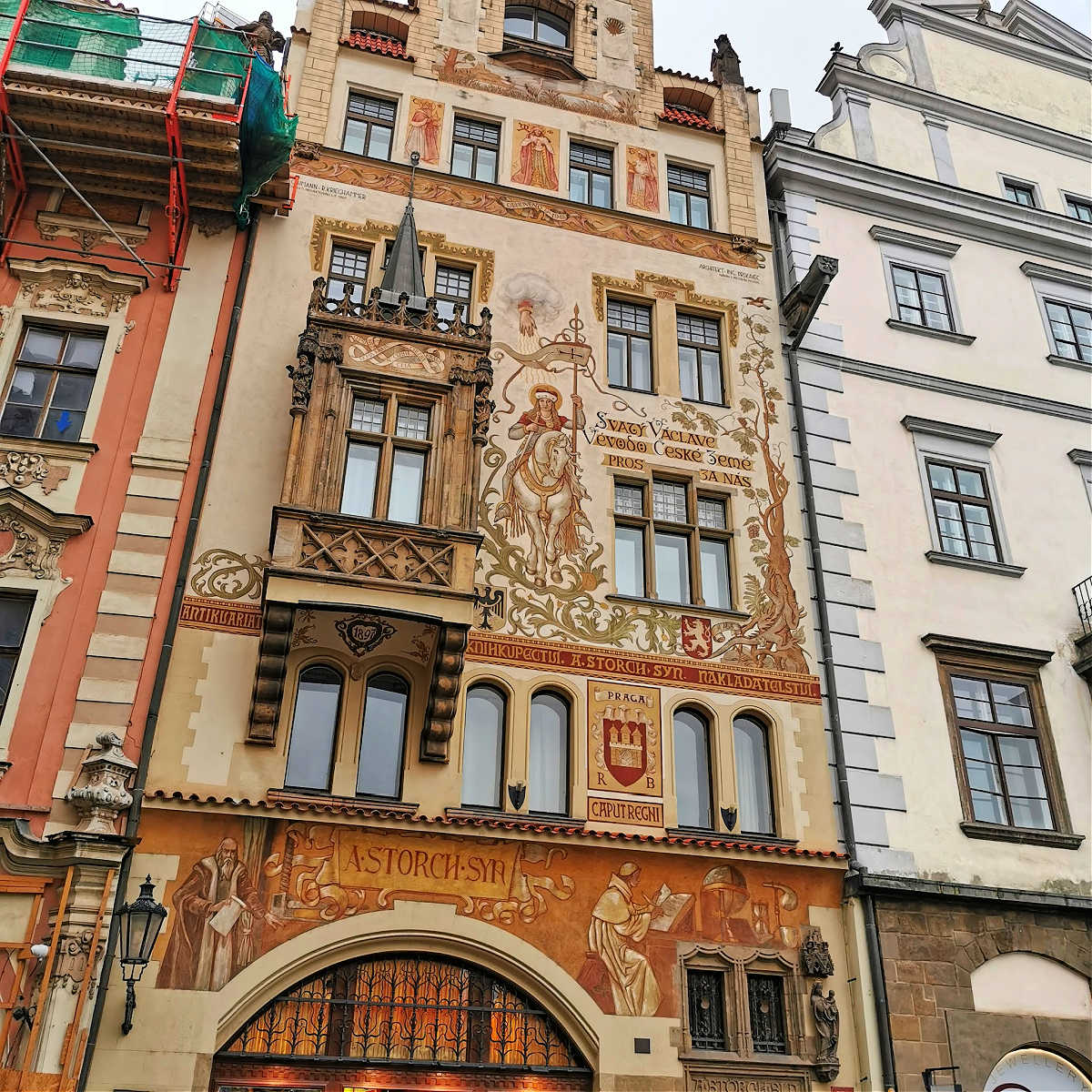
Storch’s House
Location: Old Town Square 552/16
Kafka worked in this beautifully decorated house when it was used by a lawyer Richard Lowy. He worked there as part of his work experience after he graduated in 1906.
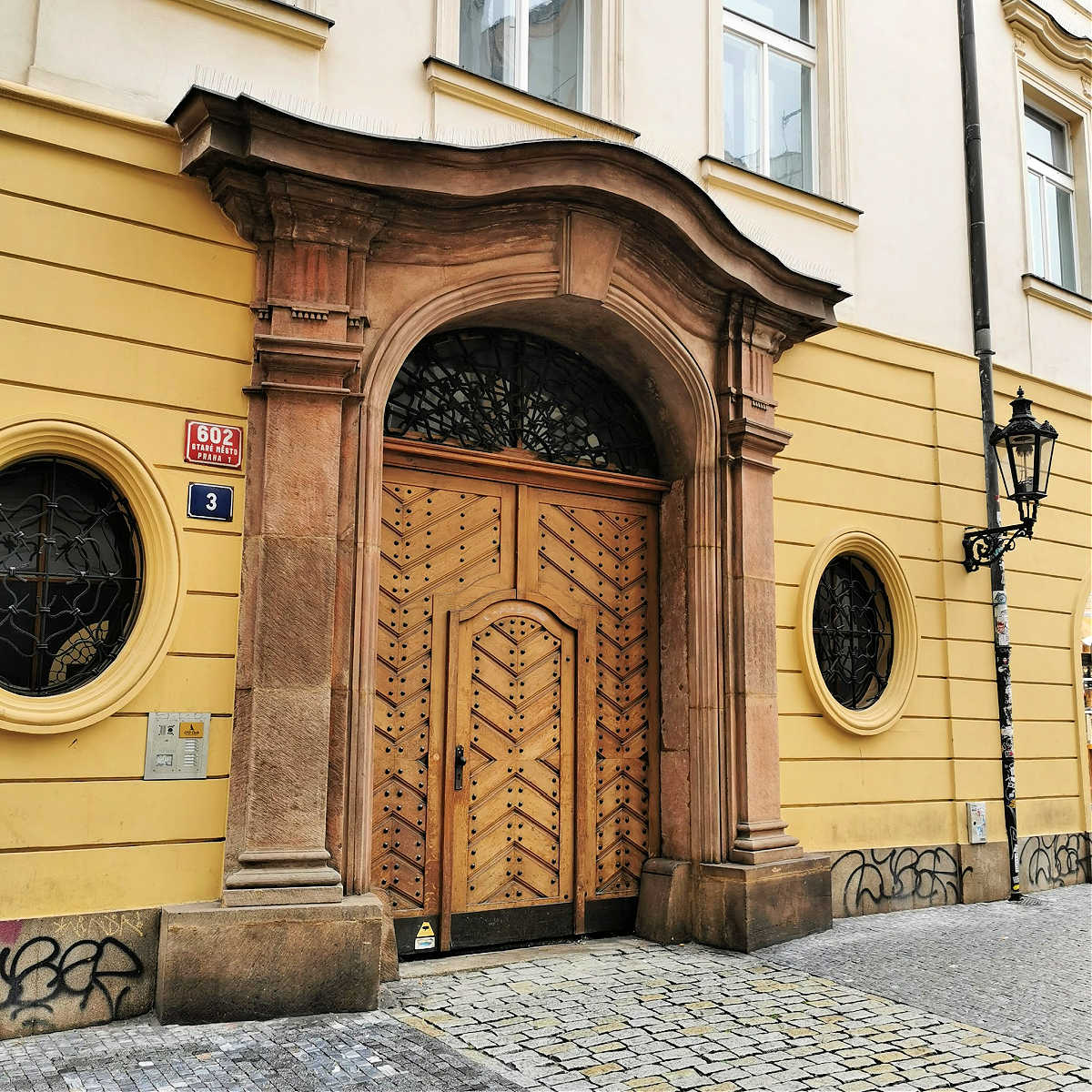
The House of Three Kings
Location: Celetna Ulice, 602/3
Kafka’s family lived here during the years 1896 – 1907 as Kafka’s father ran his haberdashery business from the same house. This is quite a significant house as Kafka started to write here.

The Franz Kafka Statue
Location: Dusni Street, Old Town
You can see Kafka’s statue between the Church of the Holy Spirit and the Spanish Synagogue in Dušní Street, where Kafka’s family once lived in a house that no longer exists. The location of the statue is not a coincidence, as the statue is exactly on the border of the Old Town and Josefov.
The statue was created by Jaroslav Róna in 2003 and it is cast in bronze, 3.75 meters high, and weighs 800 kg. The statue was inspired by Kafka’s work “Description of a Struggle.” and it looks like two bodies – one sitting on the top of the shoulders of another. The smaller figure is supposed to represent Franz Kafka himself.
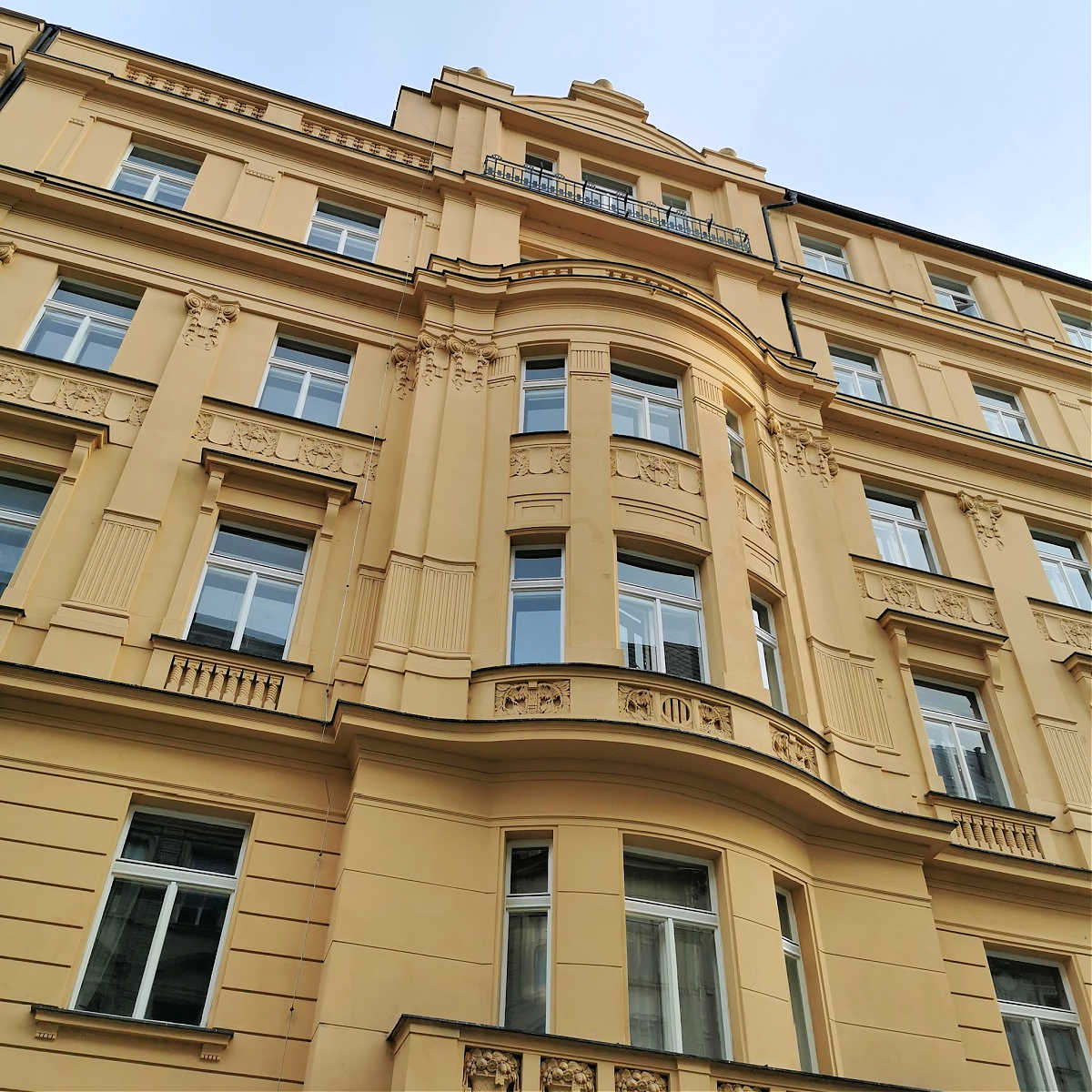
The house of a Golden Pike
Location: Dlouha Ulice (The Long Street), 705/16
Kafka lived in this house on the 5th floor between 1915-1917 and this is the flat he used to go back to after his day of writing at Golden Lane. Today the house looks very unassuming and the street is quiet and just the perfect place to live close to Old Town Square.
The Franz Kafka Museum
Location: Cihelná 635, Lesser Town
If you fancy learning more about the life and work of Franz Kafka, then you should head over to the Franz Kafka Museum. Kafka’s exhibition in the museum was originally created by Dubliner Ira James Joyce and Portuguese Fernanda Pessoy for a series of exhibitions about cities of world-important writers.
From 2002 to 2003, it was on display at the Jewish Museum in New York, and in 2005 the exhibition was moved to Hergetova Cihelna (Hergert’s Brick’s Manufacture) in Malá Strana, just a few steps from Charles Bridge.
Perhaps because this was originally done as an exhibition and then turned into a museum, there are very few exhibits, which mainly include documents or diary pages, but not actual objects that belonged to Kafka.
The museum includes a shop with a complete selection of Kafka’s works and biographical books. Entrance cost is 300 CZK for adult tickets and concessions are available.
The Schonborn Palace
Location: Trziste, 365/15, Lesser Town
In March of 1917 Kafka was looking for a flat to start a new life with his fiancee Felice Bauerova and found a very pretty flat in the newly available Schonborn Palace at the Lesser Town.
He originally loved a flat on the middle floor, but the rent was too high (600 CZK a month) and the previous tenant wanted Kafka to pay for the upgrades he had made to the flat and the furniture, for which as Kafka mentions in his diaries ‘he didn’t have the need for! Kafka settled on a smaller two-room flat on the top floor, which was more affordable. Unfortunately, he didn’t enjoy living there for too long.
On the night of August 12-13, 1917, he suffered his first serious pulmonary haemorrhage. On September 4, he was diagnosed with pulmonary tuberculosis and began to spend his time in various hospitals around Bohemia. His engagement to Felice Bauerova also ended.
Today, the building houses the Embassy of the United States of America and you can’t really take a direct photo of the house as it’s carefully guided by the security guards.
There is a memorial plaque on the facade with a bilingual text: ‘The writer, Franz Kafka lived and worked in this building in 1917. American Embassy Prague.’ I was lucky enough to go to an English College which was based in the house opposite and we had a great view of the Schonborn Palace from our classroom.
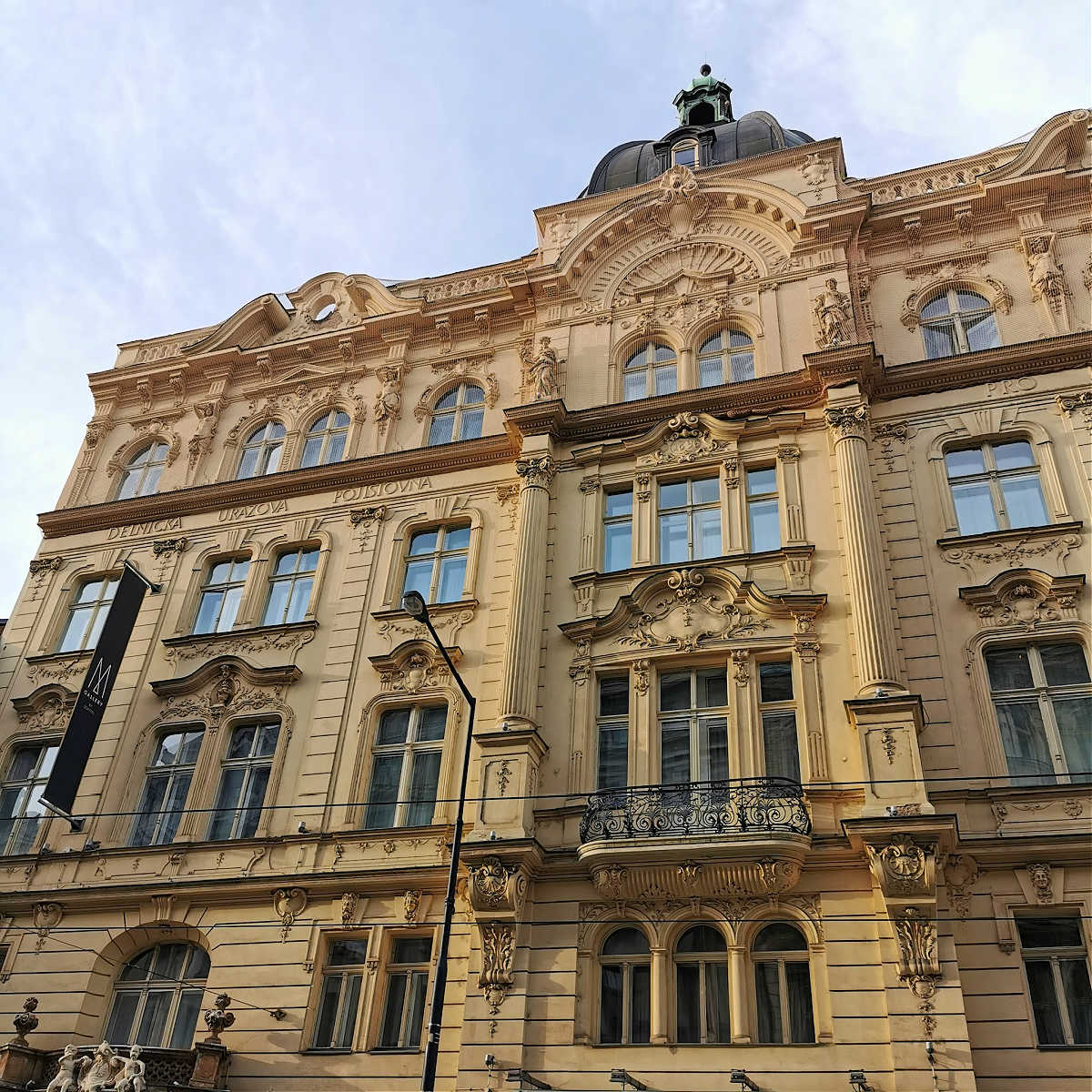
The Worker’s Accident Insurance Company House
Location: Na Porici Ulice, 1075/7
If you step back and look at this house from a distance you can clearly see the inscription ‘Delnicka Urazova Pojistovna’ meaning Workers Injury Insurance, which refers to the time when this house was an insurance company specialising in workmen’s injury claims.
Kafka worked here as a clerk from 30 August 1908 to 1 July 1922, documenting industrial accidents for the Workers’ Accident Insurance Company. He would have had to assess different cases and this experience influenced his writing, especially the themes of human struggle and the challenges faced by manual workers.
Kafka was responsible for a major industrial area in northern Bohemia, where there were mainly textile factories (Liberec, Jablonec nad Nisou, Chrastava and Frýdlant).
He worked in this insurance company for 14 years and was clearly good at his job, because he went from an assistant clerk to vice-secretary of the company within 5 years. In 1922 he was prematurely retired for health reasons.
Although he had a steady job, his real job (as he mentions in his diaries) was to write. He worked at the insurance company from 8:00 to 14:00 (only 6 hours a day). Then he would go home and sleep from 15:00 to 19:30, which he followed by a walk and a family dinner. Afterwards, he would write until two or three o’clock in the morning.
Kafka had a good salary, he annually earned about 6,500 crowns (for comparison, a manual worker at the time earned around 1,000 crowns annually).
Today, the building is a hotel and you can see a bust of Kafka in the hotel lobby to remind you that he worked there. You can even stay in the Kafka Suite, formerly room 214, which was once his office.
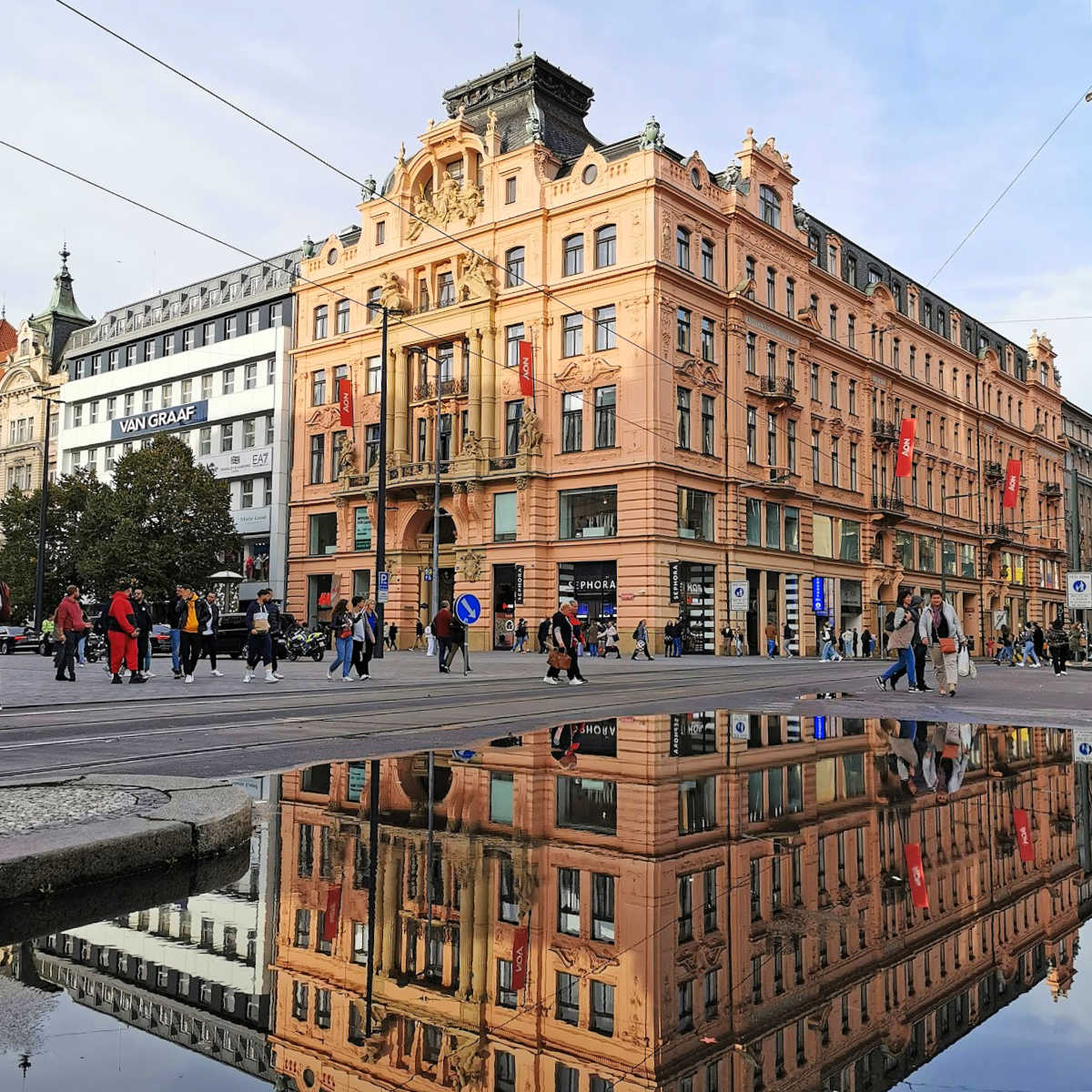
Assicurazioni Generali – Insurance Company
Location: Wenceslas Square 839/19 (corner house with Jindriska Ulice)
For about 9 months (from 1907-1908) Kafka worked at the Prague branch of this Italian insurance company. He mentions in his diaries that working at this insurance company didn’t suit him because he had to work from 8 am till 7 pm, but often until 8.30 pm in the evening.
Presumably, he didn’t like the work because it didn’t leave him much time to do his writing. This is why he moved to the next job where he worked from 8 til 2 pm only.
You can still see the company name on the house, although it’s now a place for various offices and different companies.
Café Louvre
Location: Národní 22, New Town, Prague
This historic cafe quickly became a hub for Prague writers, artists and intellectual society after it was opened in 1902.
One society a German philosophical circle was run by a writer Berta Fantova, who followed the teachings and philosophy of Franz Brentano (1838-1917) and the meetings were regularly held at the Cafe Louvre.
Members of this club included, among others, Max Brod and Franz Kafka and since the club was so popular they later had their own separate meeting room here. Although Max Brod was expelled from the club in 1905 (probably for difference of opinions) and Franz Kafka followed him out of solidarity, they continued to be regular visitors to other social evenings, public readings, and lectures held at the café.
For somebody who spent considerable time in coffee houses, Kafka must have been an interesting character to meet, because he didn’t smoke, didn’t drink alcohol, and didn’t like coffee or chocolate.
Like many historic cafes in Prague, the Cafe Louvre was closed in 1948 when the Czech communist regime didn’t really want to promote ‘aimless lazying about in the cafes’. The cafe re-opened after the Velvet Revolution in 1989 and today, it’s one of the perfect places in Prague where you can have breakfast.
The cafe has been restored back to its early 20th century glory and you can come in for a traditional Czech breakfast, lunch or light dinner and of course coffee any time of the day.
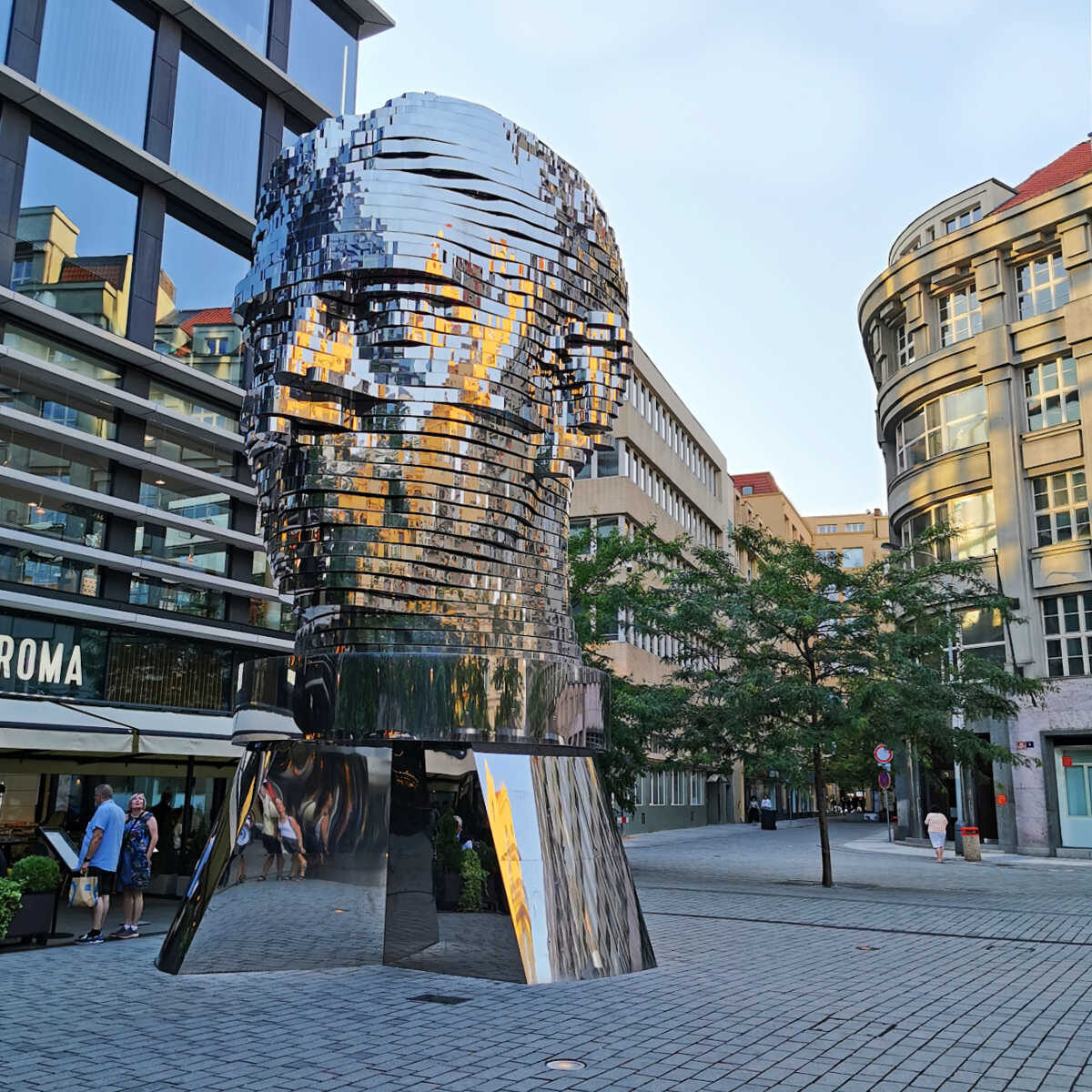
Rotating Head of Franz Kafka
Location: behind the Quadron Shopping Centre on Narodni Trida, New Town
On the same street as the Louvre coffee house you can also find another artistic tribute to Kafka in the shape of a giant head with rotating layers.
This art installation was made by David Černý and it’s constructed with over 40 movable layers that move in slightly different ways every hour. The art installation is called the Rotating Franz Kafka Head and it symbolises the many ideas, thoughts and complex thinking that must have been in Kafka’s head to write all his stories, diaries and letters.
If you are interested in following the trail of other statues in Prague, you can follow my self-guided tour of David Cerny art sculptures and explore the centre in a completely different way.
CafE Arco
Location: Dlazdena 1004/6, New Town, Prague
Café Arco is one of the historic cafes in Prague, which once was a popular meeting spot for German-Jewish writers, including Franz Kafka and his writer friend Max Brod, during the early 1900s.
Although Kafka wasn’t as frequent a visitor as Brod, it was here where he met Milena Jesenska – the writer, who also became one of the significant women in his life. Although they only met twice in real life, Kafka carried on sending Milena letters, which were later published. Milena translated his works into the Czech language.
Interestingly, although he wrote only in German, Kafka had a good command of Czech and there are several surviving letters of his written in Czech.
Sadly the cafe is now closed to the public, although it’s being used as a cafeteria by the Czech Interior Ministry. If you want to get an idea of how the cafe wouldn’t have looked like, cafe Louvre looks fairly similar.

House at Golden Lane
Location: No. 22 Golden Lane, Prague Castle – between 1916-1917
It’s a popular myth that Franz Kafka lived in house No. 22 and whilst it does have some foundation in reality it’s been embellished to promote Golden Lane as one of the places where Kafka lived.
I dug a little deeper into what actually happened and here is the full story: Kafka’s sister was renting the house (probably just for fun since she never lived there too) and Kafka borrowed the house for a period of 3 months in the winter of 1916-1917.
He would walk up there from his comfortable flat in Dlouha Street (close to the Old Town Square) and used the house to write in. He enjoyed the quietness of Golden Lane at the time and describes in his diaries that he loved walking down the new castle steps and back to his flat in the town well after midnight.
The Manes Bridge was newly finished (1914), so Kafka had quite a straightforward journey back home. The stories from this period were later published under the title “A Country Doctor.
The house now has a little commemorative plague, and there is also a shop there with all things Kafka – books, guidebooks and souvenirs.

Kafka’s Grave at the New Jewish Cemetery
Location: Zelivskeho Ulice 1, Strasnice, Prague 10
In 1917 Kafka became ill with pulmonary tuberculosis, and he spent the last years of his life mostly in sanatoriums and treatment facilities in Bohemia and abroad. He died at an Austrian sanatorium in Kierling near Klosterneuburg.
Kafka’s final resting place became the family tomb at the New Jewish Cemetery in Strašnice, which is one of the many historic cemeteries in Prague. His parents share the same burial plot and a plaque remembers his three sisters who tragically lost their lives in concentration camps during World War II.
The New Jewish Cemetery is open free to the public and you will find Kafka’s grave close to the cemetery boundary as you walk in. The large cemetery is easy to navigate and there is a sign to Kafka’s grave at the entrance to guide you to sector 21, where Kafka’s grave is located.
Last time I visited, I saw a young girl quietly eating pizza, sitting in front of Kafka’s grave on the ground, and listening to music in her earphones. After reading Kafka’s books and researching more about his life to write this blog post, I really don’t think he would have minded. I hope it wasn’t a pepperoni pizza, though, because Kafka didn’t eat meat.
This blog post was originally written on 27 October 2023 and last updated on 27 October 2023
PIN THIS GUIDE FOR LATER

